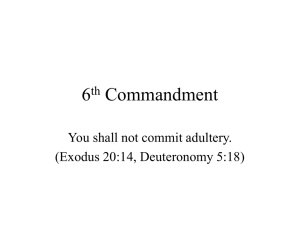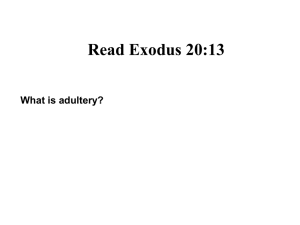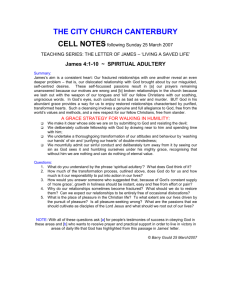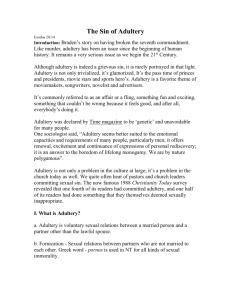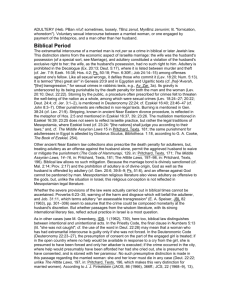Full Text
advertisement
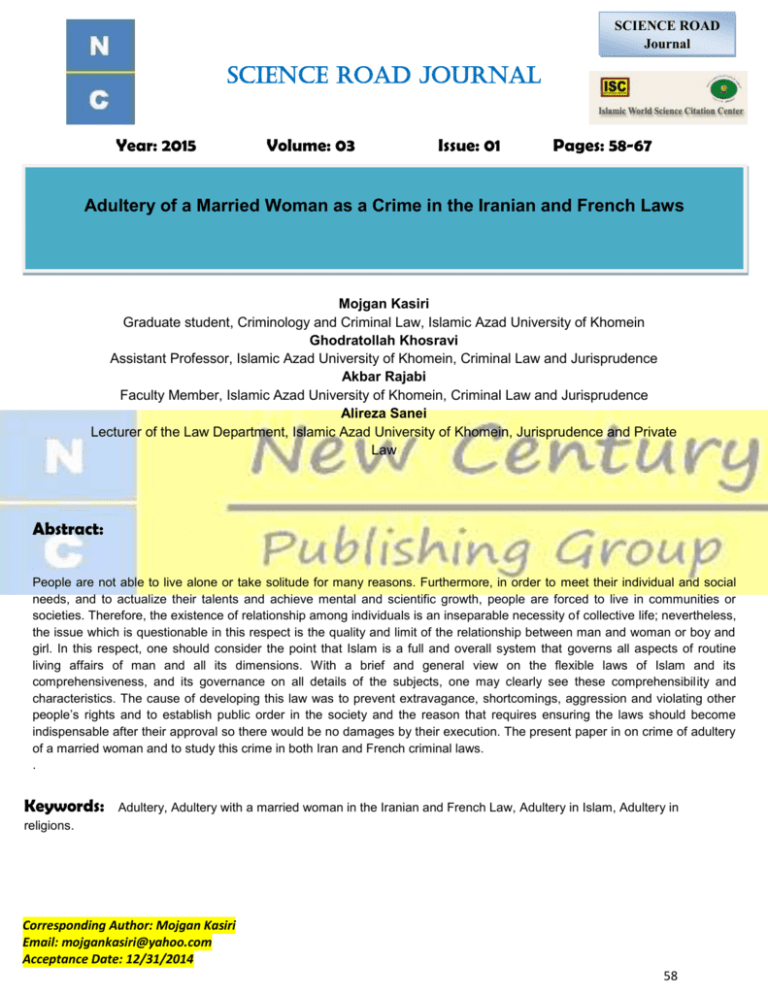
SCIENCE ROAD Journal SCIENCE ROAD JOURNAL Year: 2015 Volume: 03 Issue: 01 Pages: 58-67 Adultery of a Married Woman as a Crime in the Iranian and French Laws Mojgan Kasiri Graduate student, Criminology and Criminal Law, Islamic Azad University of Khomein Ghodratollah Khosravi Assistant Professor, Islamic Azad University of Khomein, Criminal Law and Jurisprudence Akbar Rajabi Faculty Member, Islamic Azad University of Khomein, Criminal Law and Jurisprudence Alireza Sanei Lecturer of the Law Department, Islamic Azad University of Khomein, Jurisprudence and Private Law Abstract: People are not able to live alone or take solitude for many reasons. Furthermore, in order to meet their individual and social needs, and to actualize their talents and achieve mental and scientific growth, people are forced to live in communities or societies. Therefore, the existence of relationship among individuals is an inseparable necessity of collective life; nevertheless, the issue which is questionable in this respect is the quality and limit of the relationship between man and woman or boy and girl. In this respect, one should consider the point that Islam is a full and overall system that governs all aspects of routine living affairs of man and all its dimensions. With a brief and general view on the flexible laws of Islam and its comprehensiveness, and its governance on all details of the subjects, one may clearly see these comprehensibility and characteristics. The cause of developing this law was to prevent extravagance, shortcomings, aggression and violating other people’s rights and to establish public order in the society and the reason that requires ensuring the laws should become indispensable after their approval so there would be no damages by their execution. The present paper in on crime of adultery of a married woman and to study this crime in both Iran and French criminal laws. . Keywords: Adultery, Adultery with a married woman in the Iranian and French Law, Adultery in Islam, Adultery in religions. Corresponding Author: Mojgan Kasiri Email: mojgankasiri@yahoo.com Acceptance Date: 12/31/2014 58 SCIENCE ROAD JOURNAL 1. Introduction Any social system has some norms and conventional behavioral models which are acceptable by the society and taking distance from them would give rise to deviation and bias. The intuition and inner self of man and the spirit of human society is against any force and hostility and for this reason, showing brutality is considered as deviation and bias. The historical studies show that this type of deviation is as old as human life and as the man keeps longer distance from heavenly teachings, the volume, size, variety, number and magnitude of deviations, wrong doings, crimes and man-made tragedies increase. In the religious knowledge and teachings, hostility and harming people and all other creatures, including plants and animals is prohibited and considered as ugly conduct; and in social relationship, observing each other's rights and showing kindness, compassion, sympathy, endurance and tolerance are strong norms as far as the Great Prophet of Islam calls hostility and hurting others as uglier and more unacceptable than blasphemy. Human societies today are sinking in corruption because of turning their backs to divine teachings and despite all these; they do not try to find solutions by seeking religious ways. Perhaps, the same could be true in Islamic states as well. Although the sex crimes including sexual harassment of women in Islamic countries is less often compared to other countries, especially western states due to religious, cultural and social conditions in Islamic lands; the very occurrence of those crimes reveals the fact of social and cultural damages that must be controlled deeply by using religious approaches, and social control by religion, especially through adopting the criminal policies in Islam. A view on statistics in this area shows signs of social damages and deviations; although it has not afflicted the whole society so far. Before going through the subject, I should explain that by the term "licentious" in this content, it means an act that its Quran expressions include "prostitution", "prostitute", "immoral act and "adultery". in "Arabic means back and in Arabic means woman's genitalia. 2. Theoretical foundations 2.1. Meaning of adultery Adultery means unlawful and illegitimate intercourse of a man and woman. 2.2. Definition of adultery from jurisprudents' viewpoints Adultery means the insertion of penis of a matured and mentally grown male inside the female genitalia by specifying the female sex; whether doing the act from front or back of the female, if the female is not among those allowed to have intercourse with (wife or slave), if the act is done outside wedlock, when there is a suspicion of the act being lawful or unlawful, when the penis has been inserted up to circumcision line, when they both were aware of the unlawful nature of the act and when they did the act deliberately[10]. Adultery is when the mature and grown up man, willingly and by knowledge inserts the tip of his penis inside the genitalia of a woman with whom he is not allowed to have intercourse in the absence of wedlock or ownership or in suspicious conditions [6]. Adultery is when a male inserts his penis in the back or front of a woman in a manner that the circumcision part of the penis becomes invisible, when the woman is not his lawful wife, or is not his owned slave [21]. Corresponding Author: Mojgan Kasiri Email: mojgankasiri@yahoo.com Acceptance Date: 12/31/2014 59 SCIENCE ROAD JOURNAL 2.3. Definition of adultery from the viewpoints of jurists and criminologist Unlawful Jamae or mating whether involving genitals or not is a pre-requisite for the realization of adultery, in addition to the presence of illegitimacy, deliberation and will elements, conditioning that the adulterous is grown up and matured even if the other partner (female) is under age and the condition is that the female must be adult even if her partner is under age; and the male must be mentally mature even if the partner is not mentally matured; and the woman must be mentally mature even if the partner is not mentally mature and the insertion of penis must be up to circumcision part. Furthermore, it has been said that knowledge on adultery as being a crime is the requisite of this crime [20]. The sexual act with partners whom in moral, ethical, religious and social laws are forbidden is called adultery. The most common type of this perversion is the sexual intercourse of siblings- or father and daughter (incest) [11]. 2.4. Definition of adultery from psychologists' viewpoint Sexuality or sexual derive is included in the meaning adultery. In one meaning, it means lustful activities that would attract the opposite sex or same sex and in a meaning, it includes sexual derive in biology concepts; which involves male genital or female genitalia [17]. 2.5. Definition of adultery in general Thus, by different definitions which have been presented above, in general, the evil act of adultery should be defined as: Adultery means sexual relationship in other instances than sexual act with animal, sexual intercourse by suspicion with a woman in her back if the woman is not lawfully allowed to be the man’s partner in intercourse. This crime is committed by a man and woman who are mature, mentally sane and willful with knowledge on the act and the subsequences thereof. Thus, if a man and a woman are not aware of the realization of the adultery act or did not have knowledge on the ban on sexual relationship, they will not be sentenced to Hadd (lashes) and only the partner who did have knowledge of the illegitimacy of the act will be sentenced to lashes for adultery. 3. Adultery in other religions and in Islam 3.1. Religions In the Abraham- source -religions; i.e., Judaism, Christianity and Islam, different definitions, laws and punishments have been considered in adultery; however, in most of those religions, adultery has been mentioned as an evil act and a great sin. In the Bahai religion too, such orders have been established. 3.2. Islam In Islam, adultery is a big sin and the religion has prohibited it. There are some verses in Quran on banning adultery; in particular, Al-Nesa, verses 15, 16, 22, 24 and 25, Al-Maeda, verse 5, Al-Asra, verse 32, Al Nur, verses 2, 3, 8, AlForqan, verse 68. The shortest verse in Quran on banning adultery is verse 32 Al-Asra. In verse 32- Al-Asra it writes: And do not approach adultery, as it is an evil act and a bad path! There are many narrations and Hadith on Corresponding Author: Mojgan Kasiri Email: mojgankasiri@yahoo.com Acceptance Date: 12/31/2014 60 SCIENCE ROAD JOURNAL banning adultery and the bad effects of adultery in the society. On the evil effects of adultery on the society, Imam Reza said, “Adultery is banned for corruptions it brings along such as defeat of morality, loss and distortion of the principal of kinship, failure in raising children, spoilage of inheritance, heritage, legacy and as such.” 3.2.1. Different types of adultery in Islam Adultery has different aspects, with different punishments and (Hodoud) in Islam. A) Incest B) Rape C) Adultery of unmarried person D) Adultery of married woman and man A) Incest Incest means adultery of a man with one of the women who are his family members by blood and he is not allowed to marry them. Relatives by blood include mother, sister, daughter, nice, aunt. The punishment of incest in the opinion of some of the jurisprudents is execution; however, the contents of some narrations imply that he/she should be punished by one stroke of sword on neck; if he/she survives, he/she should be detained until he/she dies; and it is better to observe this order. The execution order in the adultery with women who have become relative because of lactation or marriage, such as mother-in-law is subject of argumentation; however, the law is more strict and effective in case of step mother. In addition, in this order, there is no difference if the adulterous man is single or married. In incest, if the woman is contend to commit adultery, that woman; too, will be executed. C) Adultery of unmarried partners Adultery of unmarried partner is when the adulterous (man or woman) is single and has committed adultery willfully. In another word, the adultery of single person is called adultery of unmarried partner. The punishment of unmarried adultery is one hundred lashes in first commitment and if he commits adultery three times and has been already punished by lashes three times, his punishment in fourth time is executed. The man is lashed when he is standing up and the lashes must not hit his head, face and genital area. If a man is discovered naked in adultery, he must be lashed naked, except his private areas and if he is found having his clothes on, he will be lashed in the same manner. Woman, on the other hand, is lashed in sitting position and her body is covered by clothes. The lash must not hit her face and face. D) Adultery of married person Adultery of married person means that the adulterous has permanent spouse and have the option of having intercourse with spouse whenever he/she wishes; nevertheless, he/she had committed adultery. Simply, if a married person has intercourse with another person, his/her adultery will be called adultery of married person. The punishment of adultery of married person for a married adulterous man, if that man is old, is to lash him one hundred times, followed by stoning to death and if the adulterous is young, he should be stoned to death. Therefore, the cautious act is not to lash him. The same is true for married woman. If a man is married, has his wife available but had not have sex with her, commits intercourse with another woman, he will be lashed for one hundred times, his hair will be cut to end and he will be sent to exile to another city for one year; however, the adulterous woman does not receive hair cut punishment or exile sentences. Corresponding Author: Mojgan Kasiri Email: mojgankasiri@yahoo.com Acceptance Date: 12/31/2014 61 SCIENCE ROAD JOURNAL 3.2.2. Ways of proving adultery in Islam Generally speaking, in Islam, there are two ways to prove adultery, 1- Explicit confession, 2- Testimony of four witnesses. If the adultery of married person is proved by one of the ways mentioned above, then, the adulterous person will be stoned to death and the punishment differs regarding the means of proving adultery. 1- Confession of adulterous partners, when they are mature, mentally sane and in free will (non-slave). If he/she, willingly with no forced confesses that he/she had committed adultery and repeat his/her confession four times and to be in safe side, in four sessions, he/she will be then punished. If the married adultery is proved through confession and the adulterous person can escape from the pit when being stoned to death, he/she will not be returned to the pit, even, to be cautious; he/she had not received even one rock. 2- Testimony of four witnesses- four just man who testify that they had seen the act. If three just men and two just women testify the adultery or two just men and four just women testify, it will be sufficient and adultery is proved. If the adultery of married person is proved by the testimony of witnesses; if he/she frees himself/herself from the pit, his/her escape will be of no use and he/she should be returned to the pit to be stoned to death. 4. Punishment of Adultery of Married Person in the Iranian Criminal Law In the Public Punishment Law of 1925, if a married woman or a married man commit adultery, she/he would be sentenced to six months to three years of imprisonment. Article 312 of Civil Procedures Code ruled, those who knowingly commit one of the followings will be sentenced six months to three years of imprisonment. Article 212 of Public Procedures Code ruled,” Those who intentionally commit one of the following acts will be sentenced to six months to three years of imprisonment: 1. Any married woman who has illegitimate relationship with a man. 2. Any married man who has illegitimate relationship with a woman” and by illegitimate relationship it meant adultery. In the same article, it was stipulated,” In the clause 2 of this article, the wife and in clauses 1 and 3, the husband will serve only as a private claimant and the criminal prosecution will be upon his/her complaint and in case of reclaiming the complaint until the issuance of final verdict by the private claimant, the criminal prosecution will be stopped.” Of course, if the woman is aged 15 to 18, based on the clause B of article 207 of the same law, the adulterous man, whether married or unmarried, would be sentenced to 7 years of imprisonment. The same article ruled: “B. any man that without threatening or force has an intercourse with a female older than 15 years and younger than 18 years will be sentenced to three to seven years of imprisonment with hard labor.” The law continues with: “In the presence of any of the intensive factors in parts 1, 3, 4, 5 and 6 of clause A, the committed person will be sentenced to the mentioned punishment.” Part 6 of clause A ruled, “If the accused person is a married man” thus, the article instructed that, if a married man committed adultery with a 15 to 18 years old woman, he would be sentenced to 7 years of imprisonment, but the order of the adulterous woman, according to the same law was, “the adulterous woman who agreed with the act will be sentenced to imprisonment in correction center for juveniles for one to five years.” Therefore, the legislator in the former legal system dealt with adultery absolutely as a private matter rather than public offence and the punishment of the adultery of married woman was due to the complaint of the spouse of the accused person. On the other hand, in Islamic Punishment Law of 1991 which does not have much difference with the Islamic Punishment Act of 1982 in the manner of punishing adultery rules stoning to death for the adulterous persons as the basis of this law is Imamate jurisprudence. Article 83 of Civil Prosecution Code rules, “The limit of adultery is stoning to death in following instances: Corresponding Author: Mojgan Kasiri Email: mojgankasiri@yahoo.com Acceptance Date: 12/31/2014 62 SCIENCE ROAD JOURNAL A. The adultery of married man with a grown up and mature woman, a married man meaning a man with permanent wife and the husband has had intercourse with her when the wife was in sanity and the man had the option of having intercourse with his wife whoever he desired. B. The adultery of the married woman with a male and grown up man, the married woman being a woman with permanent husband and the husband had intercourse with her and she had the option of having intercourse with her husband.” In the first clause, the married man should be executed after being lashed and the woman should be executed. The adulterous man and woman are the persons that commit adultery by having the entire conditions of adultery and their punishment is to stone them to death with small rocks which will be described accordingly. 4.1. Adultery of married person in the criminal law of France In French law, the relationship of a man and woman with no matrimonial relationship is of three types: A) The Concubinage or Luntion (free) relationship It means sexual relationship between a woman and man when none of them is bound by wedlock. B) Adultere (married man and married woman’s adultery) The adultery, as mentioned before is the sexual relationship of a married man with a strange woman and the adultery of married woman with a strange man. C) Incest (Lincests) Adultery Incest adultery is sexual relationship with relatives by blood or marriage in a certain degree of kinship that according to the law, the person can not marry, such as the close relatives by blood or marriage as specified in articles 161, 162 and 136 of the civil procedures code of France. According to those laws, the relatives subject of incest are parents, grandparents, grandchildren, legitimate and illegitimate children and the relatives by marriage, as well as siblings, illegitimate or legitimate, uncles and aunts. In the civil procedures law of Iran, adultery is not categorized or divided and in different instances, only the term adultery or illegitimate children (children of adultery) are mentioned. 4.2. Illegitimate children in French law Essentially, with respect to article 331 of civil procedures law of France, children born by adultery could not become legitimate; however, after changes in the mentioned laws in 1907, 1915, 1941 and 1956, the legislator has permitted legitimacy of some of the children born in adultery relationship. The exceptions in the principle of banning started in the beginning of the 20th century; that is, when by virtue of the law of December 15, 1904, article 388 of the civil procedures code was abolished and the adulterous partners were allowed to marry, make a legitimate family, become spouses and legalize their relationship, it was not just and acceptable to deprive their innocent children born through the offence of the parents to take the burden of illegitimacy. Of course, some jurists justify the prohibition of making the children born by adultery legitimate and believe that the law must not allow registering those children as legitimate. Because, accepting such legitimacy is Corresponding Author: Mojgan Kasiri Email: mojgankasiri@yahoo.com Acceptance Date: 12/31/2014 63 SCIENCE ROAD JOURNAL against the best interests of the legitimate family; first and it might cause the prevalence of relationship against law and morality (adultery) and instability of the basis of family. 4.3. Study the case children from adultery committed by a man A. Children born from the adultery committed by the man In past, legitimatizing children born by adultery by a married man was possible only when the conception was made during the separation of the man and his wife and/or, during the conception, there was no legitimate child for the man; for, the jurist did not wish for a man to have several legal and legitimate children from different mothers in one time; nonetheless, that limitation was abolished by virtue of the law of July 15, 1956 and presently, by virtue of the mentioned law, it is possible to legitimize such child even if there were legitimate children from the previous marriages. B. Children born to woman as a result of adultery In evidence, the child who is born by married woman will belong to husband and will benefit from the privileges of a legitimate child. Maintaining the legitimate status of marriage is initially in favor of such a child and it must not be allowed to take him away from the family status and the first marriage even for the purpose of legitimatizing the child through the second marriage. In addition, it is only the first husband that has the capacity of rejecting the child’s kinship in blood or in another word, by rejection or denial; that is, the evidence of intercourse leading to birth of child could be waived. C. The child denied by his father or the heirs A child who is denied is rejected from the family of birth. In the meantime, by the issuance of order on rejection or denial of the child’s blood and the birth of the child through adultery is proved and ascertained, in this case, when a mother of the child marries with a man with whom she had sexual relationship, the best interests of the child requires it to allow him/her to be accepted into the new family without being illegitimated. In addition, there will be no conflict between the fathers; while, it was possible to legitimate the child who was born for a married woman. However, in the French Law, the state of natural children and the children born in adulterous relationship and incest differs. The establishment of the relationship of natural children is possible through identification of the relationship by the father or proof of ordinary natural relations through judiciary authorities, and, after the establishment of the mentioned relationship, following effects will be created. A) There is a counter unity between natural children and natural parent. B) The custody and guardianship of natural and normal child is entrusted to the parent. C) The natural child could use the last name of his natural father or mother. D) There is a genetic heritage between natural child and his/her parents; of course, the inheritance share of the illegitimate child is less than illegitimate child. Corresponding Author: Mojgan Kasiri Email: mojgankasiri@yahoo.com Acceptance Date: 12/31/2014 64 SCIENCE ROAD JOURNAL 5. Comparison between children of adultery in Iran and French Laws In the Iranian laws, according to the Islamic law and definition of Imamie jurisprudents, there were three types of adultery: Simple adultery Adultery of married spouses Incest adultery In the French law, sexual relationship outside wedlock is of three types: Free sexual relations when none of the parties is in any wedlock. Married spouses’ adultery Incest adultery 1- Children from all three types of adultery in Iranian laws are called illegitimate children (children of adultery). However, in the French Law, the child born by free relations, the natural child from wedlock and the children from adultery of married spouses or incest adultery are called children from adultery with married person or children born in incest adultery. 2- In the Iranian laws, the children of adultery whether through adultery of unmarried or married persons or incest adultery will not belong to the woman and husband. Therefore; there is no inheritance and unity between the children born for adulterous spouses; however, since in terms of biology, the child from the adultery is the child of the adulterous man or woman; therefore, marriage between the child of adultery and the adulterous people is banned and prohibited. The doctrine of marriage would be a conflict in parents and it is not reasonable for a child to have two legal fathers. 3- In the French Law, there is a legal establishment known as legitimatizing the illegitimate children by which, the natural children out of wedlock in general and children born through incest adultery whose parents are allowed to marry by permission of the president, and the children from adultery of married people in general, and the child born to adulterous woman, if her husband or heirs had already rejected the relationship of the child, or when the embryo was formed during legal separation of the spouses, the marriage of the parents (conditioned by recognizing that child was born before marriage and is alive on time of marriage) become legitimate children and their family relationship will have the same rights as the legitimate child born out of wedlock with all such rights and privileges; however, there is no such establishment in the Iranian laws. 6. Conclusion God strictly warns faithful men and women to take distance from any factors that would inflame their lusts and it is for this reason that God not only warns the Muslims from adultery in a strict way, but also He calls the Muslims to be aware of all factors that lead to adultery saying, Never approach adultery. In this phrase, Gold wants to tell that withdrawal from adulterous act does not constitute the entire duties that a Muslim man and woman should do, rather, it is proper if the Muslim man and woman keep away from any acts that lead to the adultery and do not approach checking other people, enjoying figures of others by ears and eyes or any senses that could cause being sunk in the ditch of adultery. Swear to God that this order is full of wisdom, because if any person gets close to the vortex of destruction and will sink in it even if he/she has strong arms and no matter how he/she is skillful in Corresponding Author: Mojgan Kasiri Email: mojgankasiri@yahoo.com Acceptance Date: 12/31/2014 65 SCIENCE ROAD JOURNAL swimming and fighting with the gigantic waves of sea. Regardless to all these, the strong vortex draws to itself any objects that stay around it and takes them down one by one. Each victim struggles for some moments, shows unfruitful efforts until he/she too is drowned. How wisely and beautifully Sheikh Mohammad Ghazali points it down when he says, “When we all reach to an agreement that tuberculin is a disease, we will have no arguments on preventing its breaking out.” Yes, when we accept that adultery is an evil and unacceptable act, there will be no argument in giving up the corrupted social codes and habits that prescribe women to be doll like and show off their figures and pursue unrestricted sexual relationships and taking one night stand attitudes that create the grounds of adultery. Our criteria in judging stoning to death and other laws and regulations is human rights and this criteria is based on an a priori doctrine that human right has no conflict with religion. In our previous jurisprudential researches, by quoting the opinions of one of the famous jurisprudents which was titled as “Human Rights or Rights of the Faithful Servants” we showed that the intrinsic dignity of man creates the foundation of Quran thoughts; thus, the jurisprudent system of Islam must be formed on that pillar. Although the stoning to death orders in the recent years were not in compatibility with the fundamentals of traditional jurisprudents either and it could be said that it was even against it, in any event, the purpose and sum up of this chapter is that the principal of stoning to death has no basis in Quran and is not in the best interest of society and the code of Islam, but also, it could be completely abolished and its abolishment has no conflict with being religion. In many areas such as the jurisprudential orders and regulations on execution and stoning to death and the penal liability age of children, we need new Ijtihad and jurisprudents that are not able to show Ijtihad in the current issues and events according to the narration of “act according to the events”, both they and their opinions will become history. The necessity of this is to attribute man to humanity and modify the laws accordingly. The justice administration needs to benefit from the views of experts…and we can not establish the same system which was present in the beginning of Islam. The current justice administration dictates us to have judiciary police and academic police. 7. References [1] Albaraj, A., (1992). Almohazeb. Alnashr Aleslami Lejamaetol Almodaresin. [2] Alhor, A., Mohammad, H., (2000). Vasaelol Shia Elal Tahsil Maselol Sharia. Ale Albyt Institute. Qom, Iran. [3] Altousi, A., Mohammad Bin, A., (1999). Almabsut Fi Feqhol Emamie. Maktabatol Mortazavieh, Heydarieh, Tehran. [4] Altousi, A., Mohammad bin, A., (2011). Alnahayato Fi Mojaradol Feqh Valfatavi. Darolkotob Alarabi Publication. [5] Alnajafi, M., 1995. Javaherolkalam Fi Sharho Sharaye Eslam. Darolkotob Aleslamieh, Tehran. [6] Shaker, K M., (2000). Summary Publication, Tehran. of Tafsir Almizan (Allameh Tabatabaei). Ahmadi Publication, Eslam [7] Jalili, M., (2004). Place of Woman in Islam and Judaism. Diba Publication, 1st Ed. [8] Dadmarzi, S M., (2007). Tahrir Alroza fi Shahrhol Lomea. Taha Publication. [9] Danesh, T Z., (2005). Who is the Criminal? What is Criminology?. Tehran. Corresponding Author: Mojgan Kasiri Email: mojgankasiri@yahoo.com Acceptance Date: 12/31/2014 66 SCIENCE ROAD JOURNAL [10] Dehkhoda, A A., (1998). Dehkhoda’s Lexicon. Tehran University Press. [11] Shamiati, H., (2006). Crimes against Public Interest of the Country. Vol 3. [12] Sharifi Ghorashi, B., (2003). Family System in Islam (Comparative Study). International Publication affiliated to Amir Kabir Publication Institute, 1st Ed. [13] Shoushtari, M T., (2001). Amazing Judgments (Judgments of Hazrat Ali. Payam Haq. [14] Ghorbani Lahijani, Z., (2004). Islam and Human Rights. Sayeh Publication. [15] Goldouzian, I., (2005). Parts of Civil Prosecution Code. Majd Publication. [16] Goldouzian, I., (2005). Parts of Islamic Punishment Law, Majd Publication. [17] Langroudi, M J., (2005). Terminology of Law. Alborz Publication, 15th Ed. [18] Majlesi, M B., (2000). Thesis on Law, Hodoud (Islamic punishment), Retaliation, Blood Money. Tolou Azadi Printing House, Payam Haq, first Ed. [19] Mahmoudi, A., (1980). Penal Laws of Islam, Penal emerging from Sexual Drives, Nehzat Mosalmanan Publication, Vol 2. [20] Moein, M., (2004). Persian Lexicon. Sahel Publication, 2nd Ed. [21] Mehrpour, H., (2000). Issues on Woman’s Law, Tehran, Etelaat. Corresponding Author: Mojgan Kasiri Email: mojgankasiri@yahoo.com Acceptance Date: 12/31/2014 67

